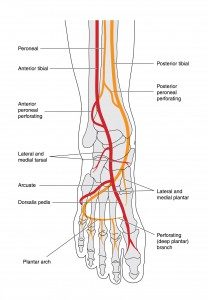Vascular Disorders
Peripheral artery disease
Your podiatric physician can do a simple test to determine if you have peripheral artery disease. The test is called an ABI, which stands for ankle-brachial index. It compares the blood pressure in your ankles with the blood pressure in your arm. If your ABI is abnormal, your podiatric physician may order other tests to determine the extent of your peripheral artery disease. Click here to see how to perform an ABI to check for poor circulation.
About peripheral artery disease
Peripheral artery disease is a highly prevalent disease characterized by blockages in the arteries of the lower extremities. Individuals with PAD face a markedly increased risk of heart attack, stroke, and death. The build-up of plaque is usually the result of atherosclerosis, or hardening of the arteries—the same condition that leads to heart artery blockages and heart attack. PAD affects 8 to 12 million Americans, and one in every five people over the age of 70 has the disease. Advanced age, smoking, diabetes, high blood cholesterol, and hypertension are key risk factors. Early detection of PAD can offer an opportunity to treat risk factors that can slow the progression of the disease and decrease the chance of heart attack and stroke. PAD affects 8 to 12 million people in the United States. Less than half of individuals with PAD know they have the disease and its corresponding increased risk of death. Use of accurate and safe diagnostic tests for PAD, such as the inexpensive, noninvasive ankle-brachial index examination (ABI) can identify patients with and at risk for PAD. Many individuals with PAD do not experience typical leg symptoms such as cramping, pain, or fatigue known as claudication. Only one-quarter of PAD sufferers are receiving treatment. Of the 2.5 million diagnosed cases, 2.1 million are medically managed. Controlling Your Risk you can decrease the risk of developing peripheral arterial disease (PAD) if you take steps to control the risk factors. Risk factors are conditions that increase your chances of developing PAD. Risk factors and other conditions that may complicate PAD include:
-
- Smoking
- High Cholesterol
- High Blood Pressure
- Physical inactivity
- Obesity
- Diabetes
What Is PAD?
 PAD is short for Peripheral Arterial Disease. PAD is caused by a blockage or narrowing of the arteries in the legs when fatty deposits called plaque build up. The buildup of plaque causes the arteries to harden and narrow, which is called atherosclerosis. This results in a reduction of blood flow to the legs and feet. This is commonly referred to as poor circulation. PAD occurs most often in the arteries in the legs, but it can also affect other arteries that carry blood outside the heart. This includes arteries that go to the aorta, the brain, the arms, the kidneys, and the stomach. When arteries inside the heart are hardened or narrowed, it is called coronary artery disease or cardiovascular disease. People with PAD have a two-to-six times’ greater chance of death from a heart attack or stroke. PAD and diabetes are the leading causes of foot or leg amputations in the United States. PAD can be treated with lifestyle changes, medicines, and surgical procedures if necessary. Since people with PAD are at high risk for heart attacks and stroke, they must take charge of controlling their risk factors related to cardiovascular disease.
PAD is short for Peripheral Arterial Disease. PAD is caused by a blockage or narrowing of the arteries in the legs when fatty deposits called plaque build up. The buildup of plaque causes the arteries to harden and narrow, which is called atherosclerosis. This results in a reduction of blood flow to the legs and feet. This is commonly referred to as poor circulation. PAD occurs most often in the arteries in the legs, but it can also affect other arteries that carry blood outside the heart. This includes arteries that go to the aorta, the brain, the arms, the kidneys, and the stomach. When arteries inside the heart are hardened or narrowed, it is called coronary artery disease or cardiovascular disease. People with PAD have a two-to-six times’ greater chance of death from a heart attack or stroke. PAD and diabetes are the leading causes of foot or leg amputations in the United States. PAD can be treated with lifestyle changes, medicines, and surgical procedures if necessary. Since people with PAD are at high risk for heart attacks and stroke, they must take charge of controlling their risk factors related to cardiovascular disease.
Treatment Options:
- Programs to stop smoking
- Blood pressure control
- Lowering cholesterol
- Manage high blood sugar (diabetes)
- Medications to prevent clotting
- Healthy diet
- Exercise program
- Surgical Procedures: A variety of surgical treatment options are available depending on the location and severity of the artery blockage. Your podiatric physician can refer you to the appropriate specialist for these procedures.
Most Common Signs of PAD:
- Fatigue, tiredness, or pain in your legs, thighs, or buttocks that always happens when you walk but goes away when you rest.
- Foot or toe pain at rest that often disturbs your sleep. Skin wounds or ulcers on your feet or toes that are slow to heal (or that do not heal for 8 to 12 weeks)
- Do not ignore leg pain. It is important to discuss any leg or thigh pain that you are having with your podiatric physician since it could be a warning sign of a serious disease such as PAD.
Information collected from the American Podiatric Medical Association, Inc
Accepted Insurance Plans
Health insurance plans in Missouri that Arch City Foot & Ankle are contracted to:
- United Health Care
- Blue Cross and Blue Shield
- Anthem BCBS
- Medicare
- Medicaid
- Railroad Medicare
- Cigna
- Aetna
- GHP
- Advantra
- Mercy
- Healthlink
- Healthcare USA
Please contact the office if your insurance plan is not listed above.
